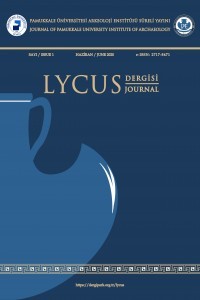Ophrynion Sikkelerindeki Hektor Başı
Ophrynion, Hektor, Korythaiolos, Grek Sikkeleri
The Head of Hector on the Coins of Ophrynion
Ophrynion, Hektor, Korythaiolos, Greek Coins,
___
- A. Akarca, “Troas’ta Aşağı Kara Menderes Ovası Çevresindeki Şehirler”, Belleten 42/165, 1-52.
- S. Altınoluk, “Ophrynion Sikkeleri,” II. Troas Değerleri Sempozyumu Kitabı, Çanakkale, 2007, 53-58.
- A Catalogue of the Greek Coins in the British Museum, Troas, Aeolis and Lesbos, (haz. W. W. Wroth), Bologna, 1964.
- A. R. Bellinger, Troy. The Coins, Princeton 1961.
- J. Borchhardt, Homerische Helme. Helmformen der Ägäis in ihren Beziehungen zu orientalischen und europäischen Helmen in der Bronze- und frühen Eisenzeit, Mainz, 1972.
- A. Camerotto, Fare gli eroi. Le strorie, le imprese, le virtù: composizione e racconto nel’epica greca arcacia, Padua, 2009.
- J. M. Cook, The Troad: An Archaeological and Topographical Study, Oxford, 1973.
- P. Cuzzolin, “Randbemerkungen über hom. κορυθαίoλος”, Graeco-Latina Brunensia 21, 2016, 117-123.
- A. Dale, “αἰόλος”, Glotta 97/1, 2021, 73-82.
- C. C. Davison – B. Lundgreen, Pheidias: The Sculptures and Ancient Sources 1, (ed. G. B. Waywell), London, 2009.
- J. M. Dosuna, “Glosografía griega y polisemia irracional: la verdadera historia de αιολος”, Ianua Classicorum 1, Madrid, 2015, 357-394.
- H. v. Fritze, “Die Elektronprägung von Kyzikos”, Nomisma 7, 1912, 1-38.
- J. Griffin, Homer on Life and Death, Oxford, 1980.
- J. T. Hooker, “Three Homeric epithets: αίγίοχος, διιπετής, ϰορυθαίολος”, Indogermanische Forschungen 84, Strassburg, 1979, 113-119.
- M. Holleaux, “Sur une inscription de Thèbes”, Revue des Études Grecques 8, 1895, 7-48 (=Études d’Épigraphie et d’Histoire Grecques 1, 1938, 1-40).
- F. Imhoof-Blumer, Monniaes grecques, Paris-Leipzig, 1883.
- P. T. Keyser, “Apollonius the Sophist on τρίγληνα”, Glotta 92, 2016, 139-144.
- R. H. Klausen, Aeneas und die Penaten: die italischen Volksreligionen unter dem Einfluss der griechischen I, Hamburg-Gotha, 1839.
- L. Lacroix, “A propos du sphinx des monnaies de Chios”, Revue Archéologique 1, 1982, 75-80.
- J. Latacz (ed.), Homers Ilias. Gesamtkommentar, Band II: 2. Gesang, Faszikel 2: Kommentar, München-Leipzig, 2003.
- G. Markwald, “κορυθαίoλος”, Lexikon des frühgriechischen Epos 10, Göttingen, 1982, 1490-1491.
- C. C. Mattusch, Enduring Bronze: Ancient Art, Modern Views, Los Angeles, 2014.
- J. N. O'Sullivan, “τρίπτυχος”, Lexikon des frühgriechischen Epos 4, Göttingen, 2008, 627.
- D. L. Page, History and the Homeric Iliad, Berkeley-Los Angeles, 1959.
- H. W. Pleket – R. S. Stroud, “SEG 31-502. Thebes. List of donations for the rebuilding of Thebes, after 316 B.C.”, Supplementum Epigraphicum Graecum 31, 1981.
- J. M. Redfield, Nature and Culture in the Iliad: The Tragedy of Hector, Durham – London, 1994.
- S. L. Schein, The Mortal Hero: An Introduction to Homer’s Iliad, Berkeley, 1984.
- Sylloge Nummorum Graecorum. Ashmolean Museum Oxford, vol. V., part. IX. Bosporus-Aeolis, Oxford, 2007.
- Sylloge Nummorum Graecorum. Deutschland. Sammlung Hans von Aulock. Troas-Aeolis- Lesbos, Berlin, 1959.
- Sylloge Nummorum Graecorum. The Royal Collection of Coins snd Medals. Danish National Museum. Troas, Copenhagen, 1945.
- Sylloge Nummorum Graecorum Fitzwilliam Museum: Catalogue of the McClean Collection of Greek Coins, vol. III. Asia Minor, Further Asia, Egypt, Africa, (haz. S. W. Grose), Cambridge, 1929.
- Sylloge Nummorum Graecorum Deutschland Staatliche Münzsammlung München, 19. Heft, Troas-Lesbos, (haz. H. R. Baldus), München, 1991.
- Sylloge Nummorum Graecorum. Turkey 9. The Özkan Arıkantürk Collection. vol. 1. Troas, (haz. O. Tekin – A. Erol Özdizbay), İstanbul, 2015.
- M. Stoevesandt – A. Bierl – J. Latacz – B. Millis, Homer’s Iliad: The Basel Commentary. Book 6, Berlin-Boston, 2015.
- W. Whallon, Formula, Character, and Context: Studies in Homeric, Old English, and Old Testament Poetry, Cambridge, 1969.
- A. Zucker, “L’appréhension grecque de la crinière : crête (λοφιά) ou chevelure (χαίτη)”, Équidés et bovidés de la Méditerranée antique Rites et combats. Jeux et savoirs, Lattes, 2014, 269-283.
- Yayın Aralığı: Yılda 2 Sayı
- Başlangıç: 2020
- Yayıncı: Pamukkale Üniversitesi
Anadolu’da Bir İlk Tunç Çağı Kenti: Küllüoba Genel Değerlendirme ve 2020 Yılı Çalışmaları
Murat TÜRKTEKİ, Deniz SARI, Fatma ŞAHİN, Sinem TÜRKTEKİ, Yusuf TUNA
Heracleia Pontica Antik Kenti’nden Heykeltıraşlık Eserleri
Hasankeyf Orta Kapı’nın Korunması ve Taşınmasına Yönelik Uygulamalar
Mesut YILMAZ, Serap SEVGİ, Cenk KOPARAN, Oğuz ÇETİN
Ophrynion Sikkelerindeki Hektor Başı
Farklı Bir Mozaik Kaldırma Tekniği - Zarflama (Controcalco)
